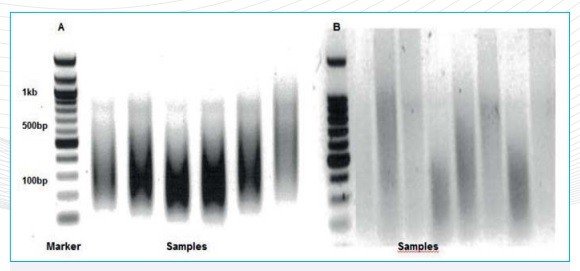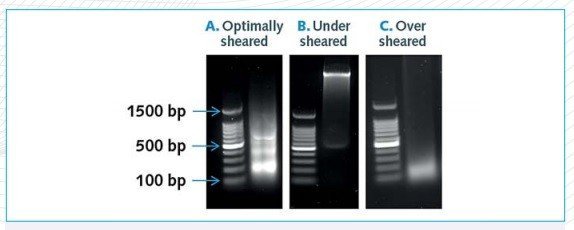For every chromatin preparation it is essential to check the chromatin is sheared to fragments between 100-500 bp. Chromatin analysis can be carried out quantitatively with a spectrophotometer, fluorometer or microfluidics platform. Samples can be qualitatively assessed using an agarose gel or microfluidics platform. Chromatrap® would recommend DNA quantification on a microfluidics platform as the most accurate measure of DNA and is highly compatible with Chromatrap® buffer systems
Problems with chromatin include over shearing which will result in very small fragments which can be detrimental for downstream processes, e.g. qPCR where the small fragments can reduce primer recognition and thus reduce PCR efficiency. Over shearing by sonication also increases the risk of damaging the protein epitopes. In comparison, under shearing will produce fragments of larger size which will result in an increase of non-specific binding in the ChIP assay.
Sonication efficiency will vary between cell types and can be affected by the extent of cross linking, heating and emulsification of the sample. These will all reduce shearing efficiency. It is important to optimise sonication to ensure a successful ChIP result. Ensure sonication tubes are used when shearing your chromatin as these are made of harder plastic which transfer ultra sonic waves more efficiently than softer plastic tubes. A good idea is to start with optimising a cell line or tissue sample which is abundant. This allows optimisation of the different parameters of your sonicator, including power setting and number of cycles. When using Chromatrap® methodology, successful shearing of cell lines and primary cells to convert fragment size (100-500 bp) has been observed using a water bath (4°C) sonicator with 30 second bursts with 30 second intervals, at a power setting of 3 for 15 minutes.

For enzymatic shearing the most important factors are; lysis of cell membranes and the concentration of enzyme. It is important to optimise the chromatin ratio in order to achieve optimal fragment lengths of between 100-500 bp. Perform a dilution series of enzyme to chromatin to determine the optimum ratio in your sample. Alternatively choose a concentration of enzyme and adjust digestion times. In Chromatrap® 1U per 5µg chromatin for 5 minutes provides optimal fragment lengths. For under sheared chromatin (400 bp and above) try increasing the U:chromatin ratio in the reaction. If chromatin is over sheared i.e. completely digested to mononucleosome fragments then the amount of enzyme to chromatin ratio should be reduced.

Alternatively cell membranes may not have been efficiently lysed, limiting access of enzyme to chromatin, check cells using a phase contrast microscope to ensure all the nuclei are released prior to proceeding to enzymatic digestion. If membranes are not efficiently lysed try incubating the samples for longer in lysis buffer. After longer incubation if cells are still resistant to lysis convert to sonication method.
If you would like more information about chromatin preparation, please do not hesitate to contact the team at Chromatrap® as we would be happy to help. You can also browse our range of solid-state ChIP kits and place your order with us today!
